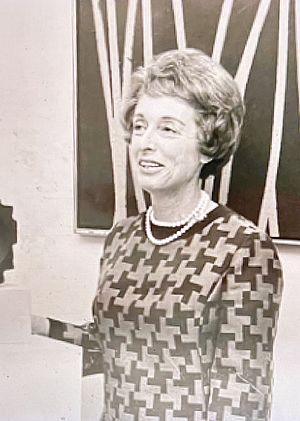Minnie Klavans facts for kids
Quick facts for kids
Minnie Klavans
|
|
|---|---|

Minnie Klavans in 1972.
|
|
| Born | May 10, 1915 Garrett Park, Maryland, U.S.
|
| Died | September 19, 1999 (aged 84) Washington, DC
|
Minnie Klavans (born May 10, 1915 – died September 19, 1999) was an American artist. Her amazing artwork is displayed in famous places. These include the Smithsonian Museum of American Art and the Baltimore Museum of Art.
Contents
Minnie Klavans: Her Life and Art
Early Life and Family
Minnie Klavans was born in Garrett Park, Maryland. Her birthday was May 10, 1915. She was the second child of Samuel and Annie Farber. Her parents had moved to the U.S. from Eastern Europe.
Minnie had two brothers. Her older brother, Leon Farber, became a jazz percussionist. Her younger brother, Melvin Farber, was a pilot. He flew planes during World War II. Sadly, he died in a training accident.
Education and New Skills
Minnie Klavans studied at Wilson Teachers College. She graduated in 1935. For a few years, she worked for the government.
In 1951, Minnie tried something new. She took a class in silversmithing. This is the art of making things from silver. She learned how to design, solder, and set stones. Her silver creations were very detailed and took a lot of time.
Minnie set up a small workshop in her home's basement. She worked hard on her new art. Just over a year later, she entered a silver pin in a contest. It was the Smithsonian Institution's Metropolitan State Art Contest. She won first place in silversmithing in 1953! The next year, she won first place again for a silver bracelet.
Even though she was great at silversmithing, Minnie decided to try painting. In 1956, she started a painting class at the YMCA. The next year, she began studying at American University. Her teacher was Luciano Penay, a new art professor.
A Career in Art
Minnie Klavans started her art career later in life, after she turned 40. She became known for her abstract paintings. These paintings used strong lines and shapes, often with bright colors. She used acrylic paint on canvas. She also worked with watercolor and felt-tip pens. She even made her own paper!
In 1958, Minnie helped start a group of 11 painters. They worked together for 35 years. This group, called Group 11, had many art shows. Their art was shown in galleries in Washington, Maryland, and Virginia.
Minnie's artwork is now part of important collections. These include the Smithsonian American Art Museum and the American University Museum.
Later Life and Legacy
Minnie Klavans kept painting and creating art. She made many different types of art until she passed away. She was 84 years old when she died in 1999.
Exhibitions and Art Collections
Minnie Klavans' art has been shown in many important places. Her pieces have been accepted into the Corcoran Gallery of Art, the Smithsonian Museum of American Art, and the Baltimore Museum of Art. Some of her work was even part of a rotating collection at the White House.
She had many solo shows, where only her art was displayed. She also participated in group shows. These exhibitions took place in Washington D.C., New York, and Madrid, Spain.
Here are some of her selected shows and collections:
- Watkins Gallery, Washington D.C. (1964)
- Corcoran Gallery of Art - Juried Area Show, Washington D.C. (1965)
- Invitational Show for Dedication of the National Bureau of Standards, Washington D.C. (1966)
- Mickelson Gallery (Four person show), Washington D.C. (1967)
- Cisneros Gallery, New York City, New York (solo show) (1967)
- Baltimore Museum of Art, Juried Art Show - Award Winner, Baltimore, Maryland (1967)
- Corcoran Gallery of Art - Juried Area Show, Washington D.C. (1967)
- Museum of Modern Art, Bilbao, Spain (One Woman Show) (1969)
- Smithsonian Institution, National Collection of Fine Arts, White House Exhibition (1970)
- Mickelson Gallery - One Woman Show (1972)
- Baltimore Museum of Art, Baltimore Maryland (1972)
- Plum Gallery, Kensington, MD (one woman show) (1977)
- National Museum of Women in The Arts, Washington, DC (permanent collection and catalog) (1986)
- Accepted in Permanent Collection and Displayed in “Art in Washington DC in the 1960s” Exhibit (2016)

